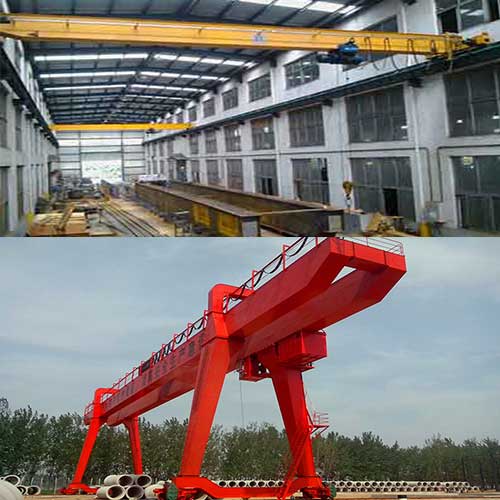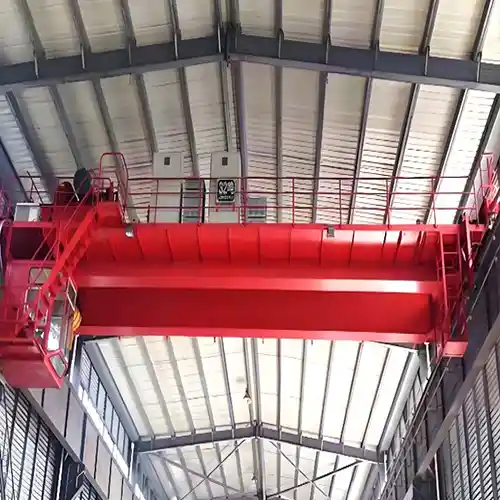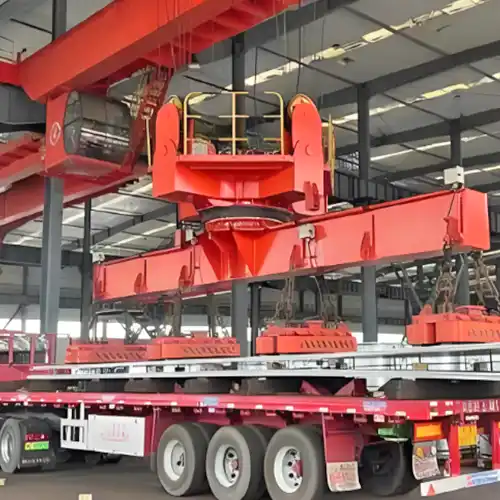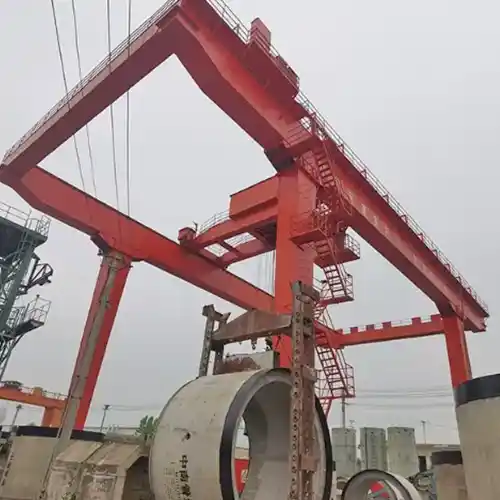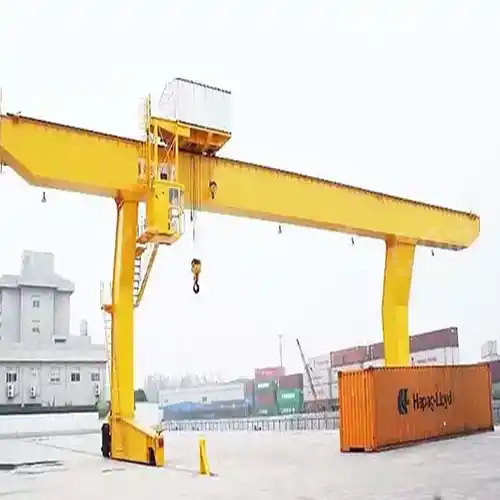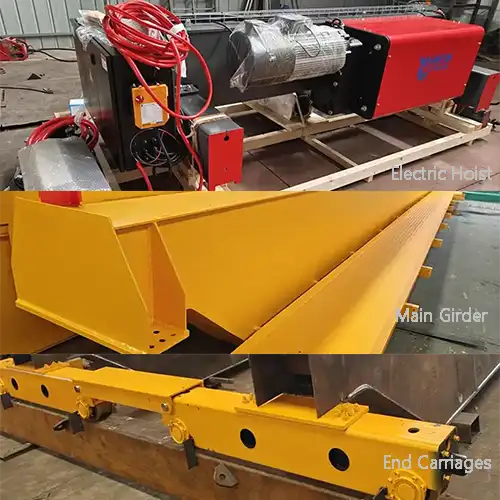Overhead Outdoor Crane & Indoor Cranes in Varied Industrial Applications
Overhead indoor cranes & outdoor cranes, with bridge crane, gantry crane & jib crane designs for diverse environments & applications,high adaptability.
Category: Overhead Crane for Your Use
Your Trusted Overhead Crane Manufacturer & Supplier
Overhead Outdoor Crane & Indoor Cranes in Varied Industrial Applications
Overhead indoor cranes & outdoor cranes, with bridge crane, gantry crane & jib crane designs for diverse environments & applications,high adaptability.
Overhead cranes customized for indoor and outdoor material handling. Types of indoor cranes & outdoor cranes, with bridge crane, gantry crane & jib crane designs cater to diverse environments & applications, emphasizing their adaptability.
Outdoor and Indoor Overhead Cranes for Varied Applications
In the realm of industrial machinery, overhead cranes stand as stalwarts, offering unparalleled assistance in lifting and moving heavy loads with precision. These impressive machines are pivotal in numerous sectors, from construction and manufacturing to logistics and beyond. Their defining trait lies in their ability to traverse diverse environments and handle a multitude of tasks, highlighting the essence of versatility within crane systems.
Overhead cranes, often referred to as bridge cranes, are a type of material handling equipment used to lift and transport heavy loads horizontally within a specific area. Typically, they consist of a bridge that runs along elevated runways, supported by parallel tracks. The lifting component, known as the hoist, moves along the bridge, enabling the crane to lift and position heavy objects precisely.
Versatility stands as a cornerstone in the design and functionality of overhead cranes. Their adaptability to various environments and their capacity to cater to an array of industries make them indispensable. The ability to seamlessly transition between indoor and outdoor settings, accommodating diverse loads and operational requirements, underscores their significance in modern industrial landscapes.
This exploration delves into the dynamic world of indoor and outdoor overhead cranes, emphasizing their adaptability and varied applications. The aim is to dissect the distinct features, functionalities, and suitability of these cranes across different environments. By highlighting their versatility, this article aims to underscore the adaptability of overhead cranes in meeting diverse industrial demands and settings.
Your Trusted Indoor Crane Manufacturer & Supplier
Indoor Overhead Cranes
Indoor overhead cranes represent a specialized category of material handling equipment designed primarily for indoor settings. They are characterized by their ability to operate within confined spaces and enclosed environments. Typically, these cranes are installed within manufacturing facilities, warehouses, and production units where precise movement and lifting of heavy loads are paramount.
Indoor cranes showcase a range of features tailored for indoor use, including compact designs, high precision controls, and enhanced safety mechanisms. Their adaptability to varying ceiling heights and layouts within confined spaces distinguishes them from their outdoor counterparts.
Types of Indoor Overhead Crane Based on Different Terms and Classifications
Indoor overhead cranes come in various types, each designed for specific applications and environments within indoor settings. They are classified based on different criteria, including their structural design, lifting mechanisms, and functionality. Here are some common types of indoor overhead cranes based on different classifications:
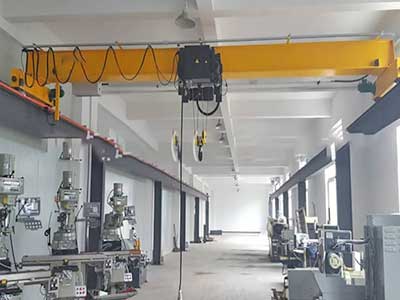
Single Girder Bridge Crane:Features a single bridge beam and is suitable for light to moderate lifting applications within confined spaces.
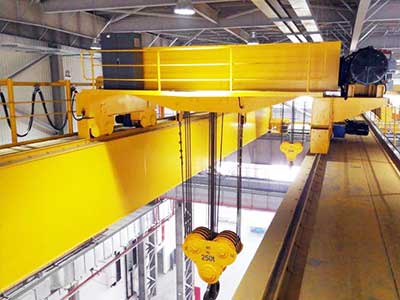
Double Girder Bridge Crane:Utilizes two bridge beams for heavy-duty lifting, offering increased load capacity and higher hook height.
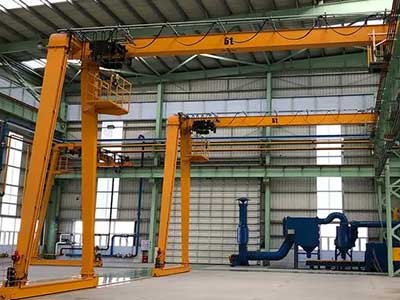
Semi-Gantry Crane:Supported by one leg and operates on a single runway beam. Suited for applications where movement is needed on one side only.
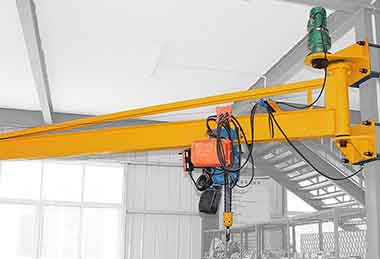
Wall-Mounted Jib Crane:Fixed to a wall or column, offering a 180-degree or 360-degree rotation, suitable for localized lifting within a specific area.
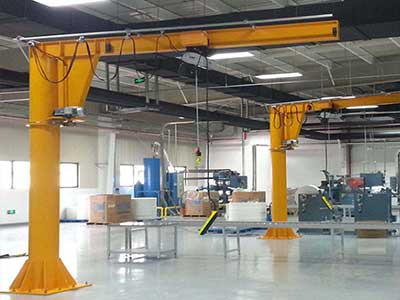
Freestanding Jib Crane:Mounted on a floor-mounted column, providing greater coverage and mobility within a workspace.

Wire Rope Hoists:- Utilize wire ropes wound around a drum for lifting heavy loads. Can be featured in both single girder and double girder bridge cranes.

Chain Hoists:- Employ chains for lifting and are often used in jib cranes or as standalone units for lighter lifting applications.
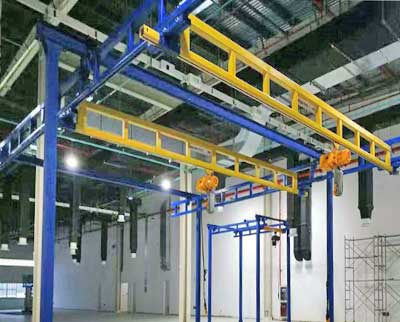
Workstation Bridge Crane:- A smaller, lighter version of a bridge crane designed for individual workstations or specific work areas within a factory or warehouse.
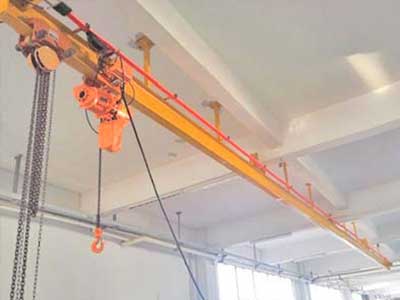
Monorail Crane:- Operates along a single rail or track, suitable for linear lifting and movement within a facility, often used for assembly lines or material handling.
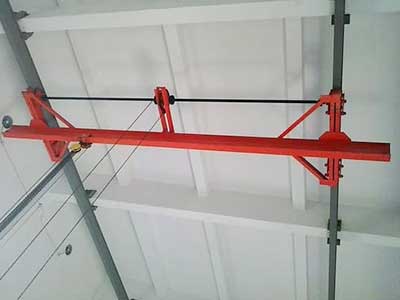
Manual Cranes: - Operated by hand or manually controlled mechanisms for lifting and movement.

Electric-Powered Cranes: - Utilize electricity to power the hoisting and movement mechanisms, offering smoother and more precise control.
Other types of Indoor Cranes
Workstation Bridge Cranes: Workstation bridge cranes are designed for specific workstations or localized areas within a facility. They typically consist of a bridge beam that runs on tracks or rails along the ceiling, allowing for horizontal movement. These cranes are suitable for precise and repetitive lifting tasks within limited spaces.
- Monorail cranes operate along a single track or rail, providing linear movement for lifting and transporting materials within a facility. They are often used in assembly lines, warehouses, or manufacturing environments where a straight-line lifting path is required.
- Factory Cranes: The term "factory crane" is a broad classification that encompasses various types of cranes utilized within manufacturing facilities. It can refer to a range of indoor overhead cranes like bridge cranes, jib cranes, or other specialized lifting equipment tailored for specific applications within a factory setting.
- Workstation Cranes: Workstation cranes encompass a range of overhead lifting systems designed to facilitate material handling and lifting operations within specific workstations or designated areas. They provide a versatile and efficient solution for lifting and moving loads in assembly lines, workshops, or manufacturing cells.
- Workshop cranes, often known as engine hoists or shop cranes, are designed for use in workshops or garages for tasks like lifting engines or heavy machinery. They are typically smaller in size and more portable compared to larger industrial cranes, offering a solution for smaller-scale lifting needs.
- Garage Cranes: Garage cranes are specifically designed for use in automotive or residential garages. They are compact and portable, enabling users to lift and move heavy items within a garage setting. These cranes often assist in tasks like engine removal or other automotive repairs.
Each type of crane serves specific purposes and is tailored to suit different operational needs within various indoor settings, whether for industrial production, assembly, workshops, or personal use in garages. Understanding their functionalities aids in selecting the most suitable crane for specific lifting requirements.
Each type of indoor overhead crane has its own advantages and is suitable for specific applications based on load capacity, workspace layout, lifting height, and other operational requirements. Understanding these classifications helps in selecting the most appropriate crane type for a particular indoor setting and operational needs.
Applications and Industries Where Indoor Cranes Excel
Indoor overhead cranes find widespread use across a spectrum of industries, including:

Manufacturing: Facilitating the movement of heavy machinery and components along assembly lines.

Warehousing: Efficiently managing and organizing inventory by lifting and transporting pallets and containers.

Automotive: Enabling the precise placement of vehicle parts during production processes.
Advantages and Limitations of Indoor Crane Systems
Advantages:
- Precision and Control: Indoor cranes offer precise and controlled movements, vital for delicate operations.
- Space Optimization: Their ability to navigate within limited spaces ensures maximum utilization of available area.
- Enhanced Safety Features: Equipped with safety mechanisms to prevent accidents and ensure operator security.
Limitations:
- Limited Mobility: Confined to indoor spaces, restricting their use to specific environments.
- Load Capacity Constraints: May have limitations concerning the maximum load they can handle compared to larger outdoor cranes.
Understanding the nuances of indoor overhead cranes unveils their specialized functionalities tailored for indoor environments, emphasizing their pivotal role in enhancing efficiency and safety within confined industrial spaces.
Specialized indoor cranes for various industrial Sectors
Different industrial sectors often have specific lifting and material handling needs. Here are specialized indoor cranes tailored for various industries:
- Automotive Assembly Line Cranes: - Workstation bridge cranes or monorail cranes designed to facilitate the movement and positioning of car parts along the assembly line. These cranes aid in the precise and efficient assembly of vehicles.
- Heavy Machinery Manufacturing Cranes: - Overhead bridge cranes, particularly double girder cranes, adapted for lifting heavy machinery components within manufacturing plants. They assist in the assembly and movement of large machinery parts.
- Warehouse Overhead Cranes: - Jib cranes, gantry cranes, or workstation cranes customized for warehouses to aid in the loading, unloading, and storage of goods. These cranes maximize space utilization and facilitate efficient logistics.
- Aerospace Manufacturing Cranes: - Specialized overhead cranes designed to handle delicate aerospace components. These cranes ensure precision, often incorporating features for anti-sway and high-precision control.
- Clean Room Cranes: - Cranes designed for clean room environments in industries like food processing and pharmaceuticals. These cranes adhere to strict cleanliness standards, often featuring stainless steel construction and specialized hoisting mechanisms.
- ESD (Electrostatic Discharge) Safe Cranes: - Overhead cranes with ESD-safe components to prevent damage to sensitive electronic components during handling and assembly processes.
- Paper Roll Handling Cranes: - Jib cranes or specialized lifting equipment designed to handle heavy paper rolls in paper mills or printing facilities, ensuring safe and efficient material handling.
- Turbine Maintenance Cranes: - Overhead cranes designed specifically for maintenance work in power plants, capable of lifting and maneuvering heavy turbine components for servicing and repairs.
Each of these specialized indoor cranes caters to the unique demands and operational requirements of different industries. They are customized to ensure safe, efficient, and precise handling of materials and components specific to their respective sectors.
Your Trusted Outdoor Crane Manufacturer & Supplier
Outdoor Overhead Cranes
Outdoor overhead cranes, in contrast to their indoor counterparts, are specifically designed to operate in open-air environments. Their distinguishing features include robust construction, weather-resistant materials, and the ability to withstand varying climatic conditions. These cranes are engineered to handle heavier loads and are adaptable to outdoor settings.
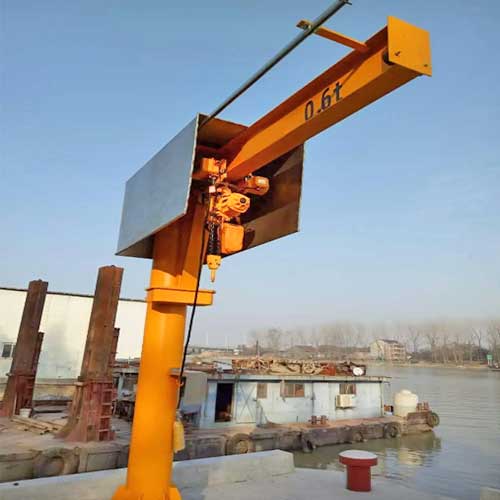
Outdoor jib cranes are similar to their indoor counterparts but are specifically designed for outdoor environments. They consist of a vertical mast mounted on a sturdy foundation or a fixed structure. At the end of the mast, there's a horizontal boom or jib that supports a hoist or lifting mechanism. Outdoor jib cranes are used in various outdoor applications such as loading docks, shipping yards, and construction sites for lifting and moving materials within a limited radius.
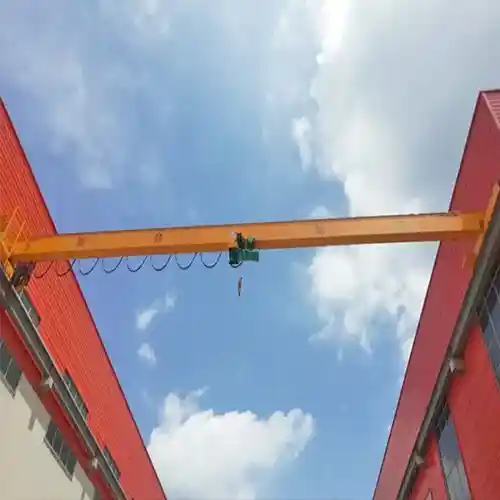
Outdoor bridge cranes function similarly to indoor bridge cranes but are built to withstand outdoor conditions. They consist of parallel runways with a traveling bridge spanning the gap. The hoist and trolley move along the bridge, facilitating lifting and movement of heavy loads across an outdoor workspace. Outdoor bridge cranes are commonly found in construction sites, shipyards, and outdoor manufacturing facilities.
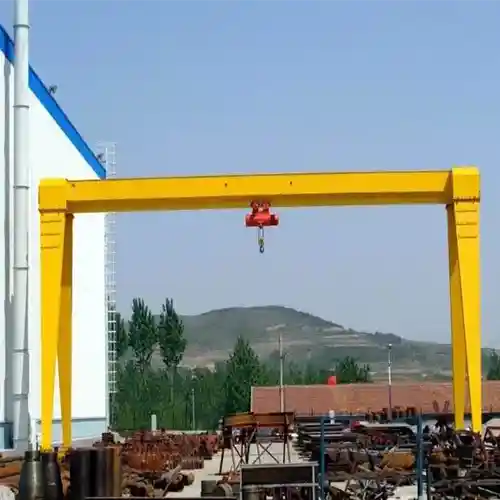
Outdoor gantry cranes, also known as portal cranes, are robust outdoor cranes supported by uprights or legs that run on rails or tracks. They have a bridge-like structure between the legs that supports the hoisting mechanism. These cranes are highly versatile and are used in outdoor locations like shipping ports, construction sites, and material yards for lifting and transporting heavy loads over larger distances.
Each of these outdoor overhead crane types offers unique advantages and is specifically designed to cater to different outdoor lifting and material handling needs. They play a crucial role in various industries by providing efficient and reliable solutions for handling heavy loads in outdoor environments.
Outdoor Cranes for Various Industrial Sectors
Various industrial sectors utilize different types of outdoor cranes tailored to their specific requirements. Here are types of outdoor cranes commonly used across different industries:

Construction Industry
Gantry Cranes for Outdoor Use in Construction:
Gantry cranes utilized in the construction sector are often employed in outdoor settings such as construction sites or areas where heavy materials need to be lifted and moved across various terrains. These cranes are supported by legs or frames and operate on tracks or wheels, providing mobility and stability for lifting and transporting heavy loads.
- Construction Material Handling:Gantry cranes are instrumental in lifting and moving construction materials like steel beams, precast concrete components, and other large and heavy construction elements within construction sites.
- Bridge Construction:They are used for lifting and placing segments during the construction of bridges, providing the necessary lifting power and mobility to work across different sections of the construction area.
Jib Cranes for Outdoor Use in Construction:
Jib cranes designed for outdoor use in construction sites consist of a vertical mast mounted on a fixed structure, providing a horizontal boom or jib with a hoist or lifting mechanism. These cranes are ideal for localized lifting and movement of materials in outdoor construction areas.
- Precise Lifting in Limited Areas:Jib cranes in outdoor construction are utilized for precise and controlled lifting and maneuvering of materials within a specific radius, often used when working in confined spaces or at specific points within the construction site.
- Loading and Unloading:They facilitate the loading and unloading of materials from trucks or trailers in outdoor construction yards, aiding in material handling tasks.
Both gantry cranes and jib cranes play essential roles in outdoor construction settings, offering solutions for different lifting requirements and enabling efficient material handling within construction sites. They contribute to streamlining construction processes and enhancing productivity in outdoor construction projects.

Shipping and Ports:
Golith Gantry Cranes for Shipping. The goliath gantry cranes play a vital role in the shipping and port industries, offering efficient cargo handling capabilities. Here's more information about gantry cranes used in ports and shipyards:
Gantry cranes in shipping and ports are large, specialized cranes that straddle cargo ships or stand beside quays. They are equipped with a horizontal bridge structure supported by legs or gantry uprights and are used for loading and unloading cargo containers from ships.
- Container Handling:Gantry cranes efficiently load and unload standardized cargo containers, transferring them between ships and storage areas like container yards or trucks.
- Logistics Operations:They facilitate the movement of goods and cargo within ports, aiding in the transfer of containers for import and export, contributing significantly to port logistics.
Special Features:
- High Lifting Capacity:Gantry cranes are designed with high lifting capacities to handle heavy cargo containers commonly used in shipping.
- Span and Reach:These cranes have wide spans and extensive reaches, allowing them to efficiently cover the width and length of cargo ships for container handling.
Types of Gantry Cranes in Ports:
- Rubber-Tired Gantry (RTG) Cranes:Mounted on wheels, RTG cranes move along the dockside for container handling within container storage yards.
Automation and Advancements:
- Some modern gantry cranes are equipped with automation features, such as remote operation and container positioning systems, improving efficiency and reducing handling times in port operations.
- Gantry cranes are integral to the smooth functioning of ports and shipyards, ensuring efficient cargo handling operations and facilitating the movement of goods between vessels and storage areas, thereby contributing to the overall logistics and trade activities within ports.

Mining and Extraction:
Explosion proof mining gantry crane for outdoor use
Explosion-proof gantry cranes are specifically designed for outdoor use in hazardous environments such as mining and extraction sites where the presence of flammable gases or dust requires specialized safety measures. These cranes are engineered to ensure safety in potentially explosive atmospheres by preventing the risk of ignition.
Explosion-proof gantry cranes in mining environments are constructed with components and features that mitigate the risk of ignition in explosive atmospheres. They are equipped with various safety measures to prevent sparks or ignition sources, adhering to stringent safety standards for hazardous environments.
Features and Applications:
- Material Handling in Hazardous Areas:These cranes are used for lifting and moving heavy loads in outdoor mining sites where explosive gases or dust may be present. They handle materials like ore, minerals, or equipment required in mining operations.
- Explosion-Proof Components:The crane's electrical systems, motors, and other components are specially designed and enclosed to prevent sparks or arcs that could cause ignition. They are often certified to meet strict safety standards, ensuring safe operation in hazardous locations.
- Robust Construction:These cranes are built with durable materials and protective coatings to withstand harsh outdoor conditions prevalent in mining environments.
- Remote Operation:Some models may feature remote control capabilities, enabling operators to control the crane from a safe distance, reducing the risk of exposure in hazardous zones.
Safety Standards and Compliance:
Explosion-proof gantry cranes must comply with relevant safety regulations and standards for hazardous locations, ensuring they meet the required specifications and certifications to operate in potentially explosive atmospheres.
These specialized gantry cranes play a crucial role in ensuring safe and efficient material handling in mining and extraction operations while addressing the specific safety challenges posed by hazardous environments.

Renewable Energy (Wind and Solar):
- Wind Turbine Installation Cranes: - Specialized cranes designed to install and maintain wind turbines. They handle heavy components like turbine blades and tower sections, crucial in the renewable energy sector.
- Heavy Component Lifting:These cranes are designed to lift and position the components of wind turbines with precision and safety, ensuring efficient assembly during wind farm construction.
- Assembly Assistance:They aid in the precise placement of turbine blades, nacelles (containing the generator and gearbox), and tower sections, enabling the construction of wind turbines at elevated heights.
Special Features:
- Height and Reach:Wind turbine installation cranes often have telescopic booms or long-reaching arms to reach the heights required for installing wind turbine components.
- High Load Capacity:These cranes are engineered to lift heavy loads safely, often featuring high load capacities suitable for handling turbine parts.

Outdoor Cranes in Manufacturing and Industrial Facilities:
Outdoor jib cranes within manufacturing and industrial facilities serve as versatile lifting solutions for outdoor work areas or assembly points. These cranes consist of a vertical mast mounted to a fixed structure or foundation, featuring a horizontal jib with a hoist or lifting mechanism.
- Localized Material Handling:Outdoor jib cranes facilitate precise and localized lifting and movement of materials within outdoor work zones, providing efficient solutions for material handling tasks in industrial settings.
- Assembly and Loading Areas:They are commonly used for loading or unloading materials onto machinery, vehicles, or assembly stations within outdoor manufacturing facilities, aiding in streamlined operations.

Log Handling Cranes in Forestry and Timber Industry:
Log handling cranes are specialized outdoor cranes employed in timber yards or forestry operations to lift, transport, and manipulate logs or timber. These cranes are pivotal in the processing and transportation of logs within the industry.
- Log Transportation:Log handling cranes efficiently lift and move logs, aiding in the transportation of timber from forest areas to processing sites or storage yards.
- Loading and Unloading:They facilitate loading logs onto trucks or other transport vehicles, as well as unloading logs for further processing or storage in timber yards or sawmills.
Each of these specialized outdoor cranes serves crucial roles in their respective industries, providing efficient solutions for material handling and aiding in the smooth execution of tasks within manufacturing, forestry, timber, and agricultural operations.
Each of these outdoor crane types caters to specific needs within various industrial sectors, ensuring efficient material handling, logistics, and operational processes in their respective fields.
Comparative Analysis of Indoor vs. Outdoor Overhead Cranes
Similarities and Differences in Functionality
Similarities:
- Both indoor and outdoor overhead cranes are designed to lift and transport heavy loads efficiently.
- They employ similar mechanisms, such as hoists, trolleys, and bridge girders, albeit tailored to suit specific environments.
Differences:
- Environmental Suitability:Outdoor cranes are built to withstand weather elements, while indoor cranes prioritize space efficiency and maneuverability.
- Design and Structure:Outdoor cranes are often larger and sturdier, while indoor cranes are more compact and customized to fit within limited spaces.
- Load Capacity:Outdoor cranes tend to have higher load capacities due to their larger size and heavy-duty construction, whereas indoor cranes cater to lighter loads as per indoor space constraints.
Adaptability to Varying Conditions and Environments
Indoor Cranes:
- Adaptability:They excel in enclosed spaces, offering precise movement within factory floors, warehouses, and assembly lines.
- Limitations:Indoor cranes might struggle with limited headroom or floor space, necessitating specialized designs like jib cranes or gantry cranes.
Outdoor Cranes:
- Adaptability:Designed to operate in diverse weather conditions, they are resilient against environmental challenges, ideal for ports, construction sites, and open yards.
- Limitations:Their larger size might be less suitable for confined indoor spaces, and exposure to weather elements could necessitate more frequent maintenance.
Efficiency, Safety, and Maintenance Considerations
Efficiency:
- Indoor cranes are adept at optimizing space and workflow efficiency within confined areas.
- Outdoor cranes excel in handling heavy loads across expansive areas, boosting logistical efficiency.
Safety:
- Both types prioritize safety, but outdoor cranes face additional challenges related to weather, making safety protocols and equipment crucial.
- Indoor cranes may have to navigate around obstacles and workers, demanding precise control and safety measures.
Maintenance:
- Outdoor cranes require robust maintenance schedules due to exposure to weather elements, requiring protective coatings and frequent inspections.
- Indoor cranes, while less exposed, still need regular maintenance to ensure optimal performance.
Factors Influencing Versatility in Overhead Crane Selection
Load Capacity and Lifting Requirements
Load Capacity:
- Indoor Cranes:Typically designed for lighter loads due to space constraints. Examples include jib cranes and workstation bridge cranes.
- Outdoor Cranes:Equipped for heavier loads owing to their larger structures. Gantry cranes and tower cranes exemplify high load-bearing capacities.
Lifting Requirements:
- Understanding the frequency, precision, and height of lifting operations helps in selecting the appropriate crane type, ensuring optimal performance and safety.
Environmental Conditions and Space Availability
Environmental Conditions:
- Indoor Cranes:Primarily shielded from external weather elements, but they need to navigate within limited indoor spaces.
- Outdoor Cranes:Built to withstand weather challenges, but their size might restrict their use in confined indoor environments.
Space Availability:
- Indoor Cranes:Tailored to operate within limited spaces like warehouses and production floors, requiring compact designs.
- Outdoor Cranes:Require ample space for movement and operation due to their larger size and range of motion.
Safety Regulations and Compliance
Safety Standards:
- Adherence to local and international safety regulations is imperative for both indoor and outdoor cranes.
- Environmental factors might necessitate additional safety measures for outdoor cranes, including wind speed considerations and weather-related protocols.
Compliance:
- Regular inspections, adherence to load capacity limits, and training programs ensure compliance with safety standards for crane operation.
Cost Implications and Long-Term Maintenance Considerations
Cost Implications:
- Initial Investment:Outdoor cranes might require a higher initial investment due to their robust construction and weather-resistant features.
- Operational Costs:Indoor cranes might have lower operational costs due to less exposure to weather and potentially lower maintenance needs.
Maintenance Considerations:
- Outdoor Cranes:Often require more frequent and comprehensive maintenance due to exposure to environmental elements like corrosion and weathering.
- Indoor Cranes:While less exposed, still require routine maintenance to ensure optimal functionality and safety.
The versatility in selecting the right overhead crane hinges on a comprehensive evaluation of these multifaceted factors. Load requirements, environmental conditions, safety regulations, and long-term maintenance considerations collectively influence the choice between indoor and outdoor cranes. Understanding these elements ensures optimal performance, safety, and cost-effectiveness in diverse operational settings.
Conclusion
Indoor and outdoor overhead crane solutions stand as indispensable assets in the landscape of modern industry. Their versatility transcends boundaries, offering tailored solutions for varied environments and applications. Indoor cranes optimize space and streamline operations within confined areas, while outdoor cranes navigate through diverse weather conditions to efficiently handle heavy loads across expansive terrains. The significance of these cranes lies in their ability to adapt to specific operational needs, enhancing productivity, safety, and efficiency across industries.
The adaptability of overhead cranes underscores their diverse applications across numerous sectors. From automotive manufacturing to port operations, construction, healthcare, and renewable energy, these cranes exhibit unparalleled adaptability. They seamlessly integrate into different operational environments, lifting heavy loads with precision, ensuring safety, and streamlining processes. Their ability to cater to various industries and applications highlights their versatility and indispensability.
Looking ahead, the future of overhead crane technology promises remarkable advancements. Anticipated innovations such as automation, AI integration, IoT-driven predictive maintenance, and modular designs will revolutionize the landscape of indoor and outdoor cranes. These advancements will not only enhance operational efficiency but also expand the scope of overhead crane applications.
The impact of these technological strides will reverberate across industries. From optimizing manufacturing processes to aiding infrastructure development and supporting renewable energy initiatives, overhead cranes will continue to play a pivotal role. Their increased adaptability, coupled with advancements in safety features and operational efficiency, will lead to safer work environments, reduced downtime, and heightened productivity in diverse sectors.
In conclusion, indoor and outdoor overhead cranes epitomize adaptability, versatility, and innovation, poised to shape the future of industrial operations while continually enhancing efficiency and safety across diverse sectors. Their evolution stands as a testament to human ingenuity, transforming the way heavy loads are handled and reinforcing their significance in the industrial landscape.
Main Projects
Related Products

Supplied three grab bucket crane kits to Indonesia, enhancing garbage handling efficiency with high load capacity and reliable performance.
Free consultation to Confirm Parameters & Specifications and Get
Latest Crane Price & Crane Rate.
- Types of overhead cranes : _______?
- Optional: Overhead travelling crane, goliath gantry crane,Slewing jib crane, Single girder or double girder crane,small portable crane or kbk crane, etc.
- Capacity of overhead crane: _______?
- Optional: 0.25ton, 0.5 ton, 1 ton, 2 ton, 3ton, 5 ton, 10 ton,15ton, 20ton, 25 ton, 30ton,35ton, up to 550ton, etc.
- Crane span & lifting height : _______?
- Crane travelling length : _____?
- Control of overhead crane:_______?
- Optional: pendant/ remote/cabin control
- Voltage supply of overhead crane:_____?
- Eg,: 380V50/60HZ,3Phase or others,etc.
- Application/usage of crane:_______?
- Eg,: Steel mill, ,injection mold, cement,stone, concrete,granite, general manufacturing, etc.
Just leave a message via the contact form and our hoist and crane engineer will contact you with in 24working hours.
Get In Touch
